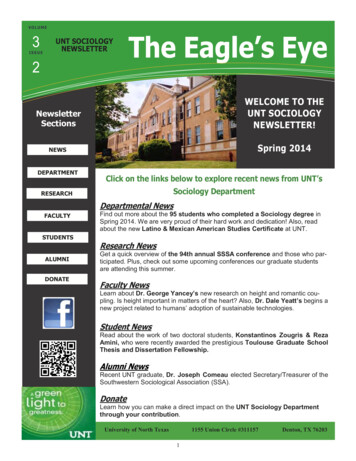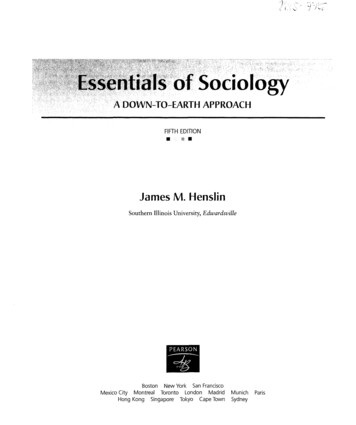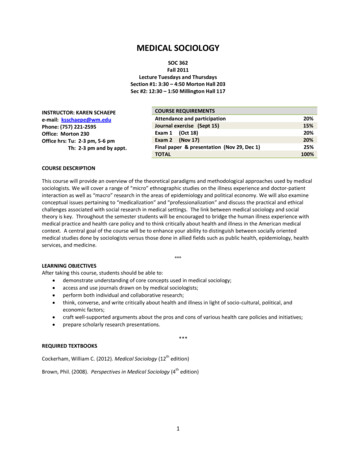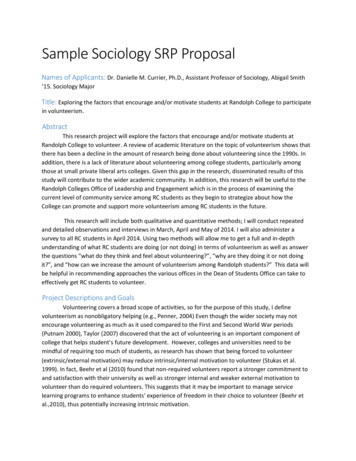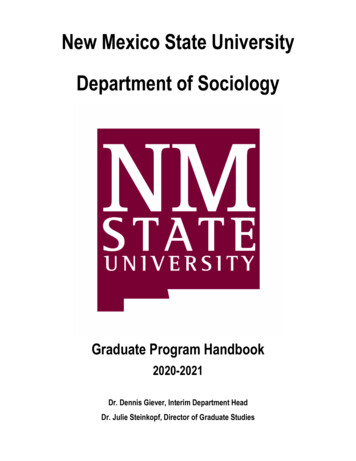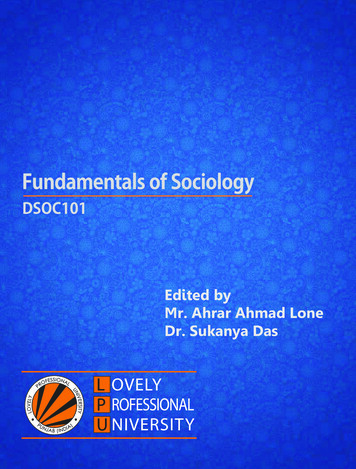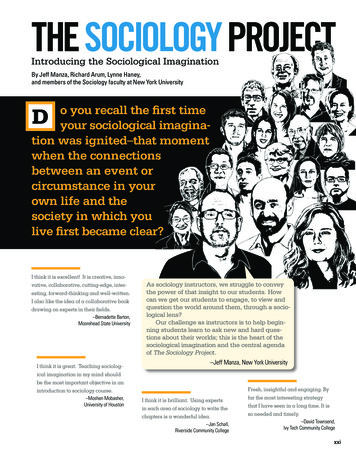
Transcription
The Sociology ProjecTIntroducing the Sociological ImaginationBy Jeff Manza, Richard Arum, Lynne Haney,and members of the Sociology faculty at New York Universityo you recall the first timeyour sociological imagination was ignited–that momentwhen the connectionsbetween an event orcircumstance in yourown life and thesociety in which youlive first became clear?dI think it is excellent! It is creative, innovative, collaborative, cutting-edge, interesting, forward-thinking and well-written.I also like the idea of a collaborative bookdrawing on experts in their fields.–Bernadette Barton,Moorehead State UniversityI think it is great. Teaching sociolog-As sociology instructors, we struggle to conveythe power of that insight to our students. Howcan we get our students to engage, to view andquestion the world around them, through a sociological lens?Our challenge as instructors is to help beginning students learn to ask new and hard questions about their worlds; this is the heart of thesociological imagination and the central agendaof The Sociology Project.–Jeff Manza, New York Universityical imagination in my mind shouldbe the most important objective in anintroduction to sociology course.–Moshen Mobasher,University of HoustonFresh, insightful and engaging. ByI think it is brilliant. Using expertsin each area of sociology to write thechapters is a wonderful idea.–Jan Schall,Riverside Community Collegefar the most interesting strategythat I have seen in a long time. It isso needed and timely.–David Townsend,Ivy Tech Community Collegexxi
hat is the best way to show my students thatsociology is not a collection of facts, but rathera process of inquiry?WRather than presenting a broad array ofconcepts and findings for students to memorize, we instead pose students a set of BigQuesTions in each of the subfields and topics in the book. Students will discover themany different ways sociologists have employed creative, and sometimes unconventional, approaches in their efforts to answerthose questions and better understand andinvestigate the social world.Because each major section in the chapteris tied to a big question, the questions serve asa road map for students and form the basis ofthe learning objectives for the chapter.Each chapter is organized around 3-6 BigQuestions that tackle the main pointsof sociological inquiry for that subfield.The Big Questions help guide students inunderstanding what’s most important.Students are introduced to the theories,concepts, and research that are central toinvestigating each Big Question in thecontext of sociological inquiry.“My greatest challenge is to find acompelling textbook that pulls studentsinto the world of sociology. I spend a lotof time looking for textbooks in general,but particularly Introduction to Sociology since there are so many to choosefrom. It is difficult to find a text thatfascinates students while seeing theworld through sociological eyes. Mostintroductory texts are too traditional;they focus on three main theories andmany different topics.”–Kim Mac Innis,Bridgewater State Universityxxii
Each Big Question is accompanied by aBig QuesTions video on MySocLabthat provides students with an overviewof the major theories, concepts, and ideasthat are explored in that section.Each chapter concludes with asection called revisiTing The BigQuesTions. Here, students can seethe Big Questions along with shortsummaries of the main points and aclearly articulated learning pathwaythrough MySocLab.“My goal is to help studentsdevelop their sociological imagination and the biggest challenge is tofind the right content and amountof readings that help do that whileat the same time introduce students to the basic concepts andtheories of the discipline. Studentsare definitely interested in the topics sociologists study, but I find it achallenge for them to fully comprehend a sociological framework.”–Rhonda Levine,Colgate UniversityThe entire instructor’s resourceprogram is tagged to the Big Questionsso you can organize, lecture, and assessstudent’s understanding of each of themajor points of sociological inquiry.xxiii
how can i engage each student’ssociological imagination?Every aspect of The Sociology Project encouragesstudents to develop and utilize their own sociologicalimaginations. Throughout each chapter, compellingexamples and critical thinking questions engagestudents.Videos, interactive maps and charts, anddynamic visualizations make the program a windowinto a wider world of discovery.“My goal is to get all students toreach beyond their grasp and toroutinely have “aha” moments.Most introductory sociology texts,unlike this one, are not intentionally designed to accomplish this;hence, my frustration at fallingshort of liberating all minds in myintro classes.”–Werner Lange,Edinboro University o nsylvaniaxxivMySocLab features documentary-style videos ineach chapter, beginning with inspiring YoursocioLogicaL iMaginaTion videos thatillustrate the chapter opening story and providea preview of the exploration to come.
auThors provide insight into theirown sociological imaginations at thebeginning of the chapter, discussingwhat drew them to the discipline andhow their sociological imaginationshave evolved over time.appLYing Your socioLogicaL iMaginaTionvideos conclude each chapter, illustrating key concepts with real-world examples. Each Applying YourSociological Imagination video is accompanied byan activity that allows students to upload their own videos or submita short essay illustrating how these concepts apply to their own lives.infographics visually highlight complex data, information,and concepts. These graphicrepresentations target particularly difficult or complex concepts that would be unwieldyto present in text form.Each Infographic comes tolife in MySocLab with a sociaLeXpLorer activity that expandson the topic and allows studentsto actively explore the data, compare change over time, and seewhat’s happening in their owncommunities.xxv
a socioLogicaL perspecTive engagesstudents’ sociological imaginations visually through photographs. Each chapterfeatures an annotated walkthrough of asocial scene with insights into questionsand observations that a sociologist mightmake while doing research.Students broaden their sociologicalperspective on MySocLab through a dynamic tour of more photos to fully complete the story. Here students engage theirsociological imaginations and are encouraged to make connections with the worldaround them.“I want students to ‘engage in’ sociology. I tell mystudents, ‘Life is sociology, sociology is life.’ If they canleave my course with a better understanding of theworld including their own personal lives, I feel like Ihave accomplished something important.”–Margaret Preble,Thomas Nelson Community CollegeThinK aBouT iT and inspire Your socioLogicaL iMaginaTionprompts accompany the Infographics and A Sociological Perspectivephoto essays to get students immediately connecting to the data andconcepts illustrated.xxvi
Contentsxxviihat are the benefits of a book authoredcollaboratively by specialists from eachsociological subfield?WStandard Introductory Sociology textbooks typicallycover 18-20 complicated topics and subfields and arewritten by one or two scholars with expertise andteaching experience in only a small subset of thosetopics. The Sociology Project, in contrast, is authoredcollaboratively by the members of the NYU Sociology Department, and coordinated by an editorialteam of Jeff Manza, Lynne Haney, and Richard Arum.Each chapter is prepared by faculty members whoteach and do research in the area. The content of eachchapter grew out of a challenge the editors posed toeach of their colleagues: What are the most importantthings undergraduates should understand about thistopic, especially if they never take another sociologycourse? How can this be conveyed without jargon orthe excessive use of complicated concepts?This program is a truly collaborative project, onein which authors have created their chapters based ondetailed feedback from both other department facultyand their undergraduates, as well as students and colleagues at institutions around the country with different student populations.xxvii
ow can i encourage students to interact withsociological data to see what’s happening inthe world, the nation, and in their own communities?h“I ask the students to understandhow to calculate basic descriptivestatistics. They are also expected tobe able to read graphs and chartsthat display statistical data.”–Romney Norwood,Georgia Perimeter CollegeThe new Social Explorer allows students toeasily engage with sociological data to seeconcepts in action, change over time, andlocal statistics.“I like the idea that students canuse the data to see trends in theircommunities because I think thatit helps them to develop theirsociological imagination and seehow sociological concepts can beapplied to their own lives andcommunities.”–Tara Hardinge,San Jose State University90% of instructors surveyedsay that quantitative literacyis important to their course.87% say it’s important toexplore change over time.87% say it’s important forstudents to be able to localize data to see social trends intheir own communities.Working with data starting in 1790 up until today, Social Exploreremploys information from the U.S. Census, American Community Survey,General Social Survey, CIA World Factbook, and more.xxviii
students are just as excitedabout the new social exploreras instructors:“It’s fantastic that it’sall in one spot. I think itwill be huge for citing inpapers it’s awesome.”“The fact that wedon’t have to extrapolateall of the Census data,that that’s compiled forus, that’s amazing.”Useful as a presentation tool in the classroom and a homework toolafter class, Social Explorer includes a number of assignments that introducestudents to important concepts in sociology using real-world data.The socioLogY proJecT includes 40 assignments unique to this programthat draw from The Big Questions and infographics in each chapter.Instructors and students can build their own presentations in Social Explorerutilizing interactive maps, charts, and graphs. Full presentations as well as individual maps and graphs can be exported to PowerPoint or image files.“To me, quantitative literacy is veryimportant; I tell my students that ifthey leave the class with anything,I hope they leave it with a healthyskepticism about statistics andhow statistics can be presented,while at the same time understanding how to interpret legitimateinformation.”–Joyce Clapp,University of North Caroline at Greensboro“Students are definitely interestedin the topics sociologists study,but I find it a challenge for them tofully comprehend a sociologicalframework.”–Rhonda Levine,Colgate Universityxxix
ow can MysocLab help my students betterprepare and engage with course materialoutside the classroom?h“(My greatest challenge) is makingthe material accessible to studentswith a wide variety of academicabilities in a large course thatdoesn’t allow for lots of one-on-oneattention.”–Jason Crockett,Kutztown University of PennsylvaniaMySocLab for The Sociology Project providesall the tools you need to engage eachstudent’s sociological imagination before,during, and after class. An assignmentcalendar and gradebook allow you to assignspecific activities with deadlines and tomeasure your students’ progress throughoutthe semester.“(My greatest challenge) is gettingstudents to come to class prepared(having completed readings, homework, etc.).”–Robyn White,Cuyahoga Community CollegeThe pearson eTeXT letsstudents access their textbookanytime, anywhere, and anyway they want, includinglistening online.xxx
A personaLiZed sTudYpLan for each student, basedon Bloom’s Taxonomy, arranges content from lesscomplex thinking—likeremembering and understanding—to more complexcritical thinking—like applying and analyzing. This layeredapproach promotes bettercritical-thinking skills, andhelps students succeed in thecourse and beyond.sociaL eXpLorer activitiesconnect to the chapter infographics as well as to broadsociological topics, engagingstudents with data visualizations,comparisons of change overtime, and data localized to theirown communities.inspiring Your socioLogicaLiMaginaTion, appLYing YoursocioLogicaL iMaginaTion, andBig QuesTions video acTiviTiesquiz students on the concepts coveredin each video and provide opportunities for students to upload and sharetheir own videos.xxxi
MYsocLiBrarY offers over 200classic and contemporary articlesthat enable students to explore thediscipline more deeply. Multiplechoice questions for each readinghelp students review what they’velearned—and allow instructors tomonitor their performance.“My greatest challenge is ensuring that the students have readthe assigned text. I also knowthat I am teaching this computergeneration, so I face the challengeof trying to incorporate as muchmultimedia information in myclass as possible.”–Karen Done,Coahoma Community College“My greatest challenge is adaptingthe course to a fully online environment.”–Jennifer Brennom,Kirkwood Community CollegexxxiisocioLogY in focus (www.sociologyinfocus.com) is a blog by sociologists for students that highlights a sociological perspective on currentevents, pop culture, and everyday life. Updated at least twice a week,Sociology in Focus is a terrific way to bring current examples into theclassroom.
ow can i encourage and assess criticalthinking with a variety of student skill levelsand enrollments?hRichard Arum, coeditor of The Sociology Project,is also the coauthor of Academically Adrift: Limited Learning on College Campuses. In a study thatfollowed 2,300 students at 24 universities overfour years, Arum measured critical-thinkingand writing skills. Arum found that more than athird of students showed no improvement in theircritical-thinking skills after four years at college.We know that the more students write,the more they strengthen their criticalthinking skills. Now, MySocLaballows you to introduce or augment a strong writing componentin your Introduction to Sociologycourse. Pathbreaking innovationsnow make possible automated scoring and feedback of student essays.“Our country today is part of aglobal economic system, wherewe no longer have the luxuryto put large numbers of kidsthrough college and universityand not demand of them thatthey are developing these higherorder skills that are necessarynot just for them, but for oursociety as a whole.”—Richard Arum, New York University“My greatest challenge is gettingstudents to do projects and paperswith sufficient analytical content.”–Pamela Forman,University of Wisconsin–Eau ClaireWriting prompts, developed by Richard Arum, encourage students tothink critically on key topics. Prompts connect key sociological concepts tocontemporary and historical issues. Student essays receive feedback on severaltraits. A detailed scoring rubric sets criteria for substantivetraits like development of ideas, focus, and coherence, aswell as writing traits like conventions and voice. Studentsare scored and receive instant feedback on each trait.This substantive feedback promotes critical thinkingabout sociology. As the instructor, you can utilize the feedback to facilitate independent revision, peer review, writing workshops, or as a first pass for your own assessment.xxxiii
how can i make the most of my timein the classroom?The insTrucTor supporT prograM for The Sociology Project is designedto help you engage your students’ sociological imaginations from the first dayof class and throughout the entire term. Each component offers maximumflexibility so you can customize to meet your needs and goals.You can instantly access these materials and more in your MySocLabaccount under Instructor Resources.“In the past I have found it difficultto choose from among an enormouspossible range of topics and approaches to cover in one semester.”–Kevin McElmurry,Indiana University NorthwestinsTrucTor’s eTeXT: The instructor’s eText offers links to relevant instructor resources and student activities in MySocLab for each chapter. You canaccess these resources by simply clicking on an icon at the start of each eTextchapter.“I usually pick and choose whichchapters to present, as I feel therejust isn't enough time in 16 weeksto properly teach all of the information in the book.”–Steve O’Boyle,Kutztown UniversityxxxivTesT iTeM fiLe: The item file for The Sociology Project has gone through arigorous development process to ensure that each question is clear, accurate,and of the highest quality. Each chapter features 125 questions that have beentagged to the Big Questions, as well as to Bloom’s Taxonomy, so you can assessand report on the outcomes that matter most to you.
MYTesT The test item file is available through MyTest, apowerful assessment-generation program that helps instructors easily create and print quizzes and exams. Questionsand tests can be authored online, giving you ultimate flexibility and the ability to efficiently manage assessments anytime and anywhere.poWerpoinT LecTure sLides: A variety of PowerPointlecture slides are available to enhance your experience infront of the class. PowerPoint slides are organized around theBig Questions and feature images, chart, graphs, and mapsfrom the text. The following formats are available:MySocLab enhanced with video and Social Explorer links embeddedTraditional image, art, and textImage and art onlyText only“My biggest challenge is gettingstudents to develop a sociologicalimagination and to recognize thevalidity of sociological research.”–Connie Robinson,Central Washington University“(My greatest challenges) arekeeping students interested andmotivated for certain chapterscovered; how to effectively teachto a class of 35 to 40 students thathave low ‘reading’ ability; and howto teach to the ‘excellent’ studentwho is in the same class as thosewho are under-prepared.”–Hence Parson,Hutchinson Community Collegexxxv
insTrucTor’s ManuaL: Authored by members of the Sociology Department at NYU, the Instructor’s Manual has been developed to support a variety of teaching styles and course goals. For each chapter, you’ll find:sample syllabi from The Sociology Project authors and instructors aroundthe country from a variety of institutionsan annotated summary of the Big Questionskey terms and definitionsteaching tips and presentation ideas drawn from the authors’ ownexperiences teaching the topiclearning outcomesdetailed chapter outlineoverview of the Infographic and A Sociological Perspective photo essayMySocLab learning pathway overviewsuggestions for teaching theoryclassroom discussion questionsshort essay questions and exercisessuggested supplemental lecture materials including websites, publications, resources on highered.org, and filmsxxxvi
your course, your bookcreate custom books with Pearsoncustom Library to give your studentsa more engaging and affordableeducation. You can delete chapters you don’t use; rearrange thechapters to suit your syllabus; and add outside readingsand content for students. Students give high marks to professors who use all oftheir required course materials. Your syllabus will run chronologically with the text,making it easier for students to follow. With a custom text, the students are only paying forwhat they use. When you control the content, youcontrol the price.how do i build a custom text?You have two options to get started.1. Go to www.pearsoncustomlibrary.com to beginbuilding the book yourself.2. Contact your Pearson representative at www.pearsonhighered.com. Click on the Educator tab, andthen click on “Find my Representative.”i’d like to include primary sourcereadings in addition to the text.You can add readings to your custom text. Place thereadings at the end of each chapter, or create an appendixof readings. Following this section is a list of our mostpopular primary source readings. These are also available onMySocLab so students can read in print or online.In addition, we have hundreds of primary sourcereadings in the Pearson Custom Library for you to choosefrom.can i use MysocLab with my customtext?Yes! MySocLab can be packaged with your custom text.Your representative will provide you with the packageISBN.TiPs and ideasfor customizing your bookyou can add: your syllabus. a “Where are They Now?” page with photosand stories from recent Sociology grads in yourdepartment to show students what you can do with adegree in Sociology. a photo and or name of a department member next tothe table of contents that discusses that professor’s areasof expertise, along with a description of their work. MLA, APA, and/or Chicago guidelines. your own commonly assigned worksheets to thetext. Place them exactly where you want them atthe end of specific chapters or create an appendix ofworksheets. your department’s plagiarism policy. your school’s code of conduct. a chapter from a different Pearson text. your MySocLab assignment directions at thebeginning or end of each chapter. a study guide of your own making. your PowerPoint lecture slides. our PowerPoint lecture slides. self-quizzing for students. notes pages at the end of each chapter. This waythe student brings the book to class and takes notesdirectly inside of it. See a template on the followingpage.am i obligated to use the Pearsoncustom book once i build it?We will send you a hard copy of your custom text in themail to review with no obligations. If you like it, yourrepresentative will provide you with an ordering ISBN. Ifyou want to make further edits, you can do so online oryour representative can help you. We will then send youanother copy to review.when do i have to give my bookstoremy custom text isbn?Printing custom texts takes approximately four weeks. Makesure your bookstore orders your custom text at least that farin advance of the start of classes.xxxvii
need a template for adding your own note taking sheets at the end ofneeda templateforfreeaddingyourownnote it,takingsheetsat theenditofeach chapter?feelto useours.Tweakmodifyit, andor useeach chapter? feel free to use ours. Tweak it, modify it, and or use itjust as it is.just as it is.notes Page examplenotes Page exampleyour name:your name:date:date:course name:course name:Topic of today’s class/lecture is:Topic of today’s class/lecture is:Main Point 1:Main Point 1:supporting evidence:supporting evidence:supporting evidence:supporting evidence:Questions i have about this main point and/or supporting evidence:Questions i have about this main point and/or supporting evidence:Main Point 2:Main Point 2:supporting evidence:supporting evidence:supporting evidence:supporting evidence:Questions i have about this main point and/or supporting evidence:Questions i have about this main point and/or supporting evidence:summary of class:summary of class:xxxviii
Primary source Readings from Pearson custom LibraryThe readings below are the most commonly included primary source readings for sociology. All of the readings below are alsoavailable in MySocLibrary on MySocLab so students can read online or in print.Go to www.pearsoncustomlibrary.com to search or browse the complete list including hundreds of readings in sociology.“Abiding Faith” by Mark Chaves“Ageism in the American Workplace” by Vincent Roscigno“The Amish: A Small Society” by John Hostetler“Are American Jews Vanishing Again?” by Calvin Goldscheider“Asceticism and the Spirit of Capitalism” by Max Weber“Becoming a Marijuana User” by Howard S. Becker“Beyond Black and White: Remaking Race in America” by Jennifer Lee andFrank D. Bean“Beyond the Melting Pot Reconsidered”by Elijah Anderson“Body Ritual Among the Nacirema” by Horace Miner“Bowling Alone: America’s Declining Social Capital” by Robert D. Putnam“Breaking the Last Taboo: Interracial Marriage in America” by Zhenchao Qian“Caring for Our Young: Child Care in Europe and the United States” by DanClawson and Naomi Gerstel“Characteristics of Bureaucracy” by Max Weber“Citizenship and Inequality: Historical and Global Perspectives” by EvelynGlenn“Class Conflict: Tuition Hikes Leave College Students in Debt and Torn BetweenPaid Work and Course Work” by Ellen Mutari and Melaku Lakew“The Code of the Streets” by Elijah Anderson“Coffee Drinking: An Emerging Social Problem?” by Ronald J. Troyer andGerald E. Markle“Color-blind Privilege: The Social and Political Functions of Erasing the ColorLine in Post Race America” by Charles A. Gallagher“The Credit Card: Private Troubles and Public Issues” by George Ritzer“Cultural Obsessions with Thinness: African American, Latina, and WhiteWomen” by Becky Thompson“Death of a Neighborhood” by Rob Gurwitt“A Different Mirror” by Ronald T. Takaki“Dilemmas of Involved Fatherhood” by Kathleen Gerson“Dumping in Dixie: Race, Class, and the Politics of Place” by Robert Bullard“Dyads, Triads, and Larger Groups” by Georg Simmel“Egalitarian Daters/Traditionalist Dates” by Mary Riege Laner and Nicole A.Ventrone“Exiles from Kinship” by Kath Weston“Facts and Fictions About an Aging America” by the Macarthur FoundationResearch Network on an Aging Society“Final Note on a Case of Extreme Isolation” by Kingsley David and Wilbert E.Moore“The Five Sexes: Why Male and Female Are Not Enough” by Anne FaustoSterling“Fraternities and Collegiate Rape Culture: Why Are Some Fraternities More Dangerous Places for Women?” by A. Ayers Boswell and Joan Z. Spade“Gemeinschaft and Gesellschaft” by Ferdinand Tönnies“The Global Economy and the Privledged Class” by Robert Perrucci and EarlWysong“A Gradual Goodbye: If People Are Living Longer, They Will Have to Work Longer Too?” from The Economist“The Great American Football Ritual: Reproducing Race, Class, and GenderInequality” by Douglas E. Foley“Growing Old in an Arab American Family” by Hani Fakhouri“Hanging Tongues: A Social Encounter with the Assembly Line” by William E.Thompson“Healing in a Hurry: Hospitals in the Managed-Care Age” by Suzanne Gordon“The Hispanic Dropout Mystery: A Staggering 30 Percent Leave School, FarMore Than Blacks or Whites. Why?” by Susan Headden“How History and Sociology Can Help Today’s Families” by Stephanie Coontz“Human Rights, Sex Trafficking, and Prostitution” by Alice Leuchtag“If Hitler Asked You to Electrocute a Stranger, Would You? Probably.” by PhilipMeyer“If Men Could Menstruate” by Gloria Steinem“If the French Can Do It, Why Can’t We?” by Stephen Greenhouse“Invitation to Sociology” by Peter L. Berger“Let Them Eat Fat” by Greg Critser“The Looking-Glass Self ” by Charles Horton Cooley“Maid to Order: The Politics of Other Women’s Work” by Barbara Ehrenreich“Manifesto of the Communist Party” by Karl Marx and Friedrich Engels“Mate Selection and Marriage Around the World” by Bron B. Ingoldsby“The McDonaldization of Society” by George Ritzer“The Meaning of Social Control” by Peter L. Berger“Media Magic: Making Class Invisible” by Gregory Mantsios“The Medically Uninsured: Will They Always Be With Us?” by Steven A.Schroeder“Mexican Americans and Immigrant Incorporation” by Edward E. Telles“Millions for Viagra, Pennies for Diseases of the Poor” by Ken Silverstein“Names, Logos, Mascots, and Flags: The Contradictory Uses of Sport Symbols” by Stanley D. Eitzen“The Nanny Chain” by Arlie Hochschild“The Nature of Symbolic Interactionism” by Herbert Blumer“Navigating Public Places” by Joe R. Feagin and Melvin P. Sikes“Night to His Day: The Social Construction of Gender” by Judith Lorber“On Being Sane in Insane Places” by D.L. Rosenhan“Opinions and Social Pressure” by Solomon E. Asch“Parents’ Socialization of Children” by D. Terri Heath“Positive Functions of the Undeserving Poor: Uses of the Underclass in America” by Herbert Gans“The Power Elite” by C. Wright Mills“The Presentation of Self in Everyday Life” by Erving Goffman“Race and Class in the American Criminal Justice System” by David Cole“Race Matters” by Cornel West“Race-Specific Policies and the Truly Disadvantaged” by William Julius Wilson“Racial Stratification and Education in the United States: Why Inequality Persists” by John U. Ogbu“Rethinking Crime and Immigration” by Robert J. Sampson“The Rich Get Richer and the Poor Get Prison” by Jeffrey Reiman“The Saints and the Roughnecks” by William J. Chambliss“Savage Inequalities: Children in America’s Schools” by Jonathan Kozol“Sense and Nonsense About Surveys” by Howard Schuman“Sex and Temperament in Three Tribes” by Margaret Mead“The Sick Role and the Role of the Physician Reconsidered” by Talcott Parsons“Sixteen Impacts of Population Growth” by Lester R. Brown, Gary Gardner, andBrian Halweil“Socialization: The Internalization of Reality” by Peter L. Berger“Some Principles of Stratification” by Kingsley David and Wilbert E. Moore“Some Principles of Stratification: A Critical Analysis” by Melvin Tumin“Sometimes the Perfect Mate Is Someone You Hardly Know” by Andy Steiner“The Souls of Black Folk” by W.E.B. Du Bois“Suspended Identity: Identity Transformation in a Maximum Security Prison” by Thomas J. Schmid and Richard S. Jones“Talking Past Each Other: The Black and White Language of Race” by RobertBlauner“Thinking About the Baby: Gender and Divisions of Infant Care” by SusanWalzer“Thoughts on Class, Race, and Prison” by Alan Berkman and Tim Blunk“Through a Sociological Lens: Social Structure and Family Violence” by RichardJ. Gelles“Use of Black English and Racial Discrimination in Urban Housing Markets” by Douglas Massey and Garvey Lundy“The Uses of Global Poverty: How Economic Inequality Benefits the West” byDaina Stukulis Eglitis“The Way We Weren’t: The Myth and Reality of the “Traditional” Family” byStephanie Coontz“What Does it Mean to Be Human?: Human Nature, Society, and Culture” byJoel M. Charon“What Is Marriage For?” by E.J. Graff“When Work Disappears” by William Julius Wilson“Where’s Papa?: Disappearing Dads Are Destroying Our Future” by DavidPopenoe“Women and Men in the Careg
Ivy Tech Community College I think it is brilliant. Using experts in each area of sociology to write the chapters is a wonderful idea. -Jan Schall, Riverside Community College I think it is great. Teaching sociolog-ical imagination in my mind should be the most important objective in an introduction to sociology course. -Moshen Mobasher,



